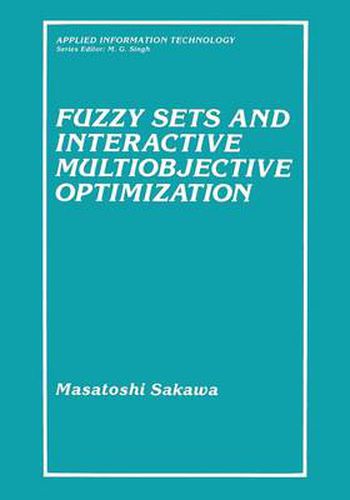Readings Newsletter
Become a Readings Member to make your shopping experience even easier.
Sign in or sign up for free!
You’re not far away from qualifying for FREE standard shipping within Australia
You’ve qualified for FREE standard shipping within Australia
The cart is loading…






This title is printed to order. This book may have been self-published. If so, we cannot guarantee the quality of the content. In the main most books will have gone through the editing process however some may not. We therefore suggest that you be aware of this before ordering this book. If in doubt check either the author or publisher’s details as we are unable to accept any returns unless they are faulty. Please contact us if you have any questions.
The main characteristics of the real-world decision-making problems facing humans today are multidimensional and have multiple objectives including eco nomic, environmental, social, and technical ones. Hence, it seems natural that the consideration of many objectives in the actual decision-making process re quires multiobjective approaches rather than single-objective. One ofthe major systems-analytic multiobjective approaches to decision-making under constraints is multiobjective optimization as a generalization of traditional single-objective optimization. Although multiobjective optimization problems differ from single objective optimization problems only in the plurality of objective functions, it is significant to realize that multiple objectives are often noncom mensurable and conflict with each other in multiobjective optimization problems. With this ob servation, in multiobjective optimization, the notion of Pareto optimality or effi ciency has been introduced instead of the optimality concept for single-objective optimization. However, decisions with Pareto optimality or efficiency are not uniquely determined; the final decision must be selected from among the set of Pareto optimal or efficient solutions. Therefore, the question is, how does one find the preferred point as a compromise or satisficing solution with rational pro cedure? This is the starting point of multiobjective optimization. To be more specific, the aim is to determine how one derives a compromise or satisficing so lution of a decision maker (DM), which well represents the subjective judgments, from a Pareto optimal or an efficient solution set.
$9.00 standard shipping within Australia
FREE standard shipping within Australia for orders over $100.00
Express & International shipping calculated at checkout
This title is printed to order. This book may have been self-published. If so, we cannot guarantee the quality of the content. In the main most books will have gone through the editing process however some may not. We therefore suggest that you be aware of this before ordering this book. If in doubt check either the author or publisher’s details as we are unable to accept any returns unless they are faulty. Please contact us if you have any questions.
The main characteristics of the real-world decision-making problems facing humans today are multidimensional and have multiple objectives including eco nomic, environmental, social, and technical ones. Hence, it seems natural that the consideration of many objectives in the actual decision-making process re quires multiobjective approaches rather than single-objective. One ofthe major systems-analytic multiobjective approaches to decision-making under constraints is multiobjective optimization as a generalization of traditional single-objective optimization. Although multiobjective optimization problems differ from single objective optimization problems only in the plurality of objective functions, it is significant to realize that multiple objectives are often noncom mensurable and conflict with each other in multiobjective optimization problems. With this ob servation, in multiobjective optimization, the notion of Pareto optimality or effi ciency has been introduced instead of the optimality concept for single-objective optimization. However, decisions with Pareto optimality or efficiency are not uniquely determined; the final decision must be selected from among the set of Pareto optimal or efficient solutions. Therefore, the question is, how does one find the preferred point as a compromise or satisficing solution with rational pro cedure? This is the starting point of multiobjective optimization. To be more specific, the aim is to determine how one derives a compromise or satisficing so lution of a decision maker (DM), which well represents the subjective judgments, from a Pareto optimal or an efficient solution set.